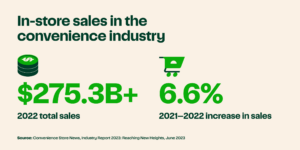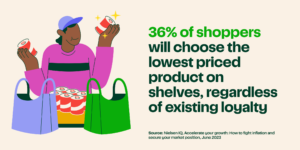Take a second look at your promotion effectiveness
Retailer demand for more — and better — CPG promotions is holding constant. This is an optimistic indicator that RGM teams can help CPGs drive results for their business.

But at the same time, it’s never been more challenging to forecast how trade promotions perform. Historically well-performing promotions might not hold water in today’s rapidly-changing market. And last year’s calendar can’t guarantee consistent results.
RGM teams today are thinking critically about promotions for best-selling products. But beyond that, they’re also accounting for promotion effectiveness by channel, region, and at the national level. Juggling this information is challenging — and it’s leading to missed opportunities.
So how do you know if your trade promotions are going to be effective?
Follow changing market conditions
CPG brands who follow changing market conditions are equipped to pivot with changes as they come — but brands that take a reactive approach are falling behind. If anniversary-ing last year’s promotion strategies into this year’s calendar is how you’re planning your trade promotions, consider how today’s market is fluctuating in comparison to last year’s. Those conditions may change how your promotions will perform.
We often see three recurring drivers of market volatility.
Driver #1: Price changes
CPGs have been gradually raising prices — initially to mitigate the economic impact of the COVID-19 pandemic, and more recently what has become ongoing inflation. Promotions can help protect margins as input prices rise by offering discounts, cash back, or BOGOs. Nielsen reports that promoted sales supported 6% growth for CPGs as of September 2023.
But not all promotions are created equal. A 2-for-$5 offer today, for example, doesn’t provide the same incentive as a 2-for-$4 offer did 1–2 years ago. Even though the structure is similar, the value of the offer is not as powerful, and neglecting to test this structure can lead to underperforming promotions. Additionally, routinely offering the same price reductions or BOGOs can lead to fatigue and a decline in effectiveness — even if those offers have historically performed well. Moreover, offering the same structure as your traditional go-to promotions, just at a higher threshold, can serve as a signal to consumers that you’ve raised your prices.
Driver #2: New competition in new channels
CPGs are facing competition in channels where they’ve historically had the upper hand. The convenience channel, for example, is seeing growth in grocery and fresh foods sales. In fact, 40% of surveyed consumers purchase grocery staples from c-stores, and regional suppliers predict a growth in health-focused products being offered at c-stores throughout 2024. Value retailers are seeing an uptick in consumer engagement, as well: nearly 43% of CPG sales were completed in the value channel in 2023, siphoning sales from other retail channels where CPG typically performs stronger. And 69% of consumers are purchasing CPG products at pharmacies. These shifts can disrupt CPG’s historical conditions for powerful performance and transition their focus to spread across different channels. Historical or traditional promotions will likely not help them stay competitive in new territory.

Driver #3: Consumer impulsivity
Expecting consumers to follow routines can lead to promotions that fail to deliver. That’s because consumers don’t follow patterns: They act on impulse. Consumers are influenced by offers they see in the moment, and will often make snap judgments depending on the offers they encounter. And, with omnichannel shopping offering greater visibility than ever, consumers are willing to drop retailer and brand loyalty for better promotions — or lower prices — elsewhere.

With these factors — and more — affecting promotion performance, it’s never been more clear that anniversary-ing promotions can’t guarantee continued effectiveness.
Analyze your promotions at every level
So what steps can you take to combat market volatility? We asked our customer success team, who works closely with RGM teams every day, about strategies that keep promotions fresh, effective, and compelling. They advise to take a step back, observe the entire market, and observe how your promotions are performing at these levels:
• National
• Regional
• Channel
• Retailer
National
Approach trade promotion effectiveness from a top-down view, starting with nationwide performance. This can help establish a baseline for architectures, pricing, and offers that resonate with consumers and retailers.
Regional
A promotion may perform well in one region, but not garner results in another. You can use factors like household income, retailer density, and competition when you examine trade promotions from a regional perspective. This information will help you develop targeting tactics, understand regional trends, and strengthen your strategies in the long run.
Channel
Consider how channels influence promotion effectiveness. Convenience store shoppers, for example, have different priorities than grocery store or dollar store shoppers — and fluctuating price points are key drivers of a promotion’s performance. For example, CPG brands in drugstores may offer promotions with large discounts to offset existing high prices. On the other hand, CPG brands in dollar stores may offer smaller discounts that are proportional to existing low prices.
It’s not always a straightforward process to convince retailers to adopt new promotion architectures, but backing your new promotions with multi-level analyses can help them feel confident in executing your recommendations in-market.
Retailer
By combining these insights, you can diversify with granular promotions optimized to achieve specific retailer goals, such as larger baskets or enhancing margins. Every retailer has their own unique shopper base, and promo calendars are built at the account level. Retailer-specific testing allows you to target consumers at your key accounts and tailor promo strategies accordingly. Consider presenting new, innovative offers to retailers instead of the same promotions you’ve historically relied on. This way, you can proactively anticipate, identify, and test new strategies specifically for your shared consumers.
Analyzing and adjusting promotions is the best, most reliable way to stay agile and diversify on a rolling basis. And experimentation can help you do just that — by identifying what levers to pull to improve promotions at every level.
Supercharge trade promotion effectiveness with experimentation
If there is value in diversifying with new strategies, how can you know which promotion architectures to actually diversify with? After all, RGM isn’t an exact science. Every promotion is a calculated risk that may or may not pay off. If you’re feeling pressure to deliver — and/or defend — effective promotions for your CPG brand, the best way to mitigate risk is to experiment with tools designed specifically for RGM.
Experimentation helps your team gain a clear understanding of how your current promotions stack up against new offers. Leading RGM tools test real promotions for real products, with real consumers, in real time. The insights you gain from testing are backed by concrete evidence from in-store and online sales — and you can present them to internal sales stakeholders — and even retailers — with confidence.
By testing trade promotions with experimentation-based tools, you can identify new strategies that you may have never considered before.
Procure the right tools to enhance promotion effectiveness
Your promotion strategy — and its success — is up to you. Anniversary-ing the same promotions across channels, regions, or nationwide might work in the short term, but those models will eventually go stale.
Hoping your trade promotions will continue performing well isn’t a strategy. Being prepared with RGM tools that enable real-time market pivots is. After conducting a review of your promotions at every level and instituting the right tools to support an agile approach to your in-market effectiveness and decisions, you’ll be able to position your team for long-term success that takes your strategy from reactive to proactive.
Offer Innovation from Eversight by Instacart is an AI-powered tool that ingests all of your promotion data — from traditional and innovative promotion strategies — and identifies which promotions can continue running in market, along with promotions that can be retired. Offer Innovation also crafts new promotions that your team can implement into your existing trade promotion strategy with high confidence.
The best way to diversify your trade promotions is to test your strategies with software designed for RGM teams.
Know what works before you invest. Verify and test.
See how Offer Innovation can impact your promotion effectiveness today.